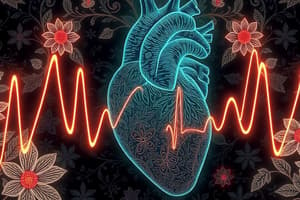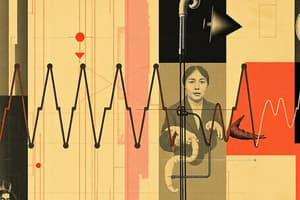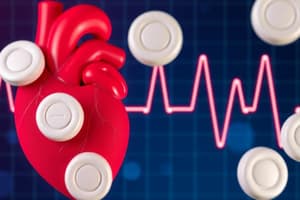Podcast
Questions and Answers
What is the underlying cause of many tachydysrhythmias that antiarrhythmic drugs aim to address?
What is the underlying cause of many tachydysrhythmias that antiarrhythmic drugs aim to address?
- Elevated potassium levels
- Decreased vagal tone
- Increased myocardial contractility
- Re-entry circuits (correct)
Which of the following best describes how antiarrhythmic drugs generally affect cardiac cells?
Which of the following best describes how antiarrhythmic drugs generally affect cardiac cells?
- They specifically target and destroy abnormal pacemaker cells.
- They alter membrane ion conductance, which influences the characteristics of action potentials. (correct)
- They directly enhance the force of cardiac contractions.
- They increase the speed of electrical impulse propagation throughout the myocardium.
What is the direct effect of excessive vagal tone on the heart that some antidysrhythmics aim to counteract?
What is the direct effect of excessive vagal tone on the heart that some antidysrhythmics aim to counteract?
- It normalizes blood pressure.
- It causes bradydysrhythmias. (correct)
- It causes tachydysrhythmias.
- It increases the heart rate.
Which property of myocardial tissue is most directly affected by Class I antiarrhythmics?
Which property of myocardial tissue is most directly affected by Class I antiarrhythmics?
How do Class II antiarrhythmics (beta-blockers) help to reduce sympathetic-induced tachycardia?
How do Class II antiarrhythmics (beta-blockers) help to reduce sympathetic-induced tachycardia?
How do Class III antiarrhythmics, such as amiodarone and sotalol, exert their effects on the action potential?
How do Class III antiarrhythmics, such as amiodarone and sotalol, exert their effects on the action potential?
Which phase of the cardiac action potential is primarily affected by Class IV antiarrhythmics (calcium channel blockers)?
Which phase of the cardiac action potential is primarily affected by Class IV antiarrhythmics (calcium channel blockers)?
Adenosine is used to treat re-entry supraventricular tachycardia (SVT). What is its primary mechanism of action?
Adenosine is used to treat re-entry supraventricular tachycardia (SVT). What is its primary mechanism of action?
A patient with a known history of asthma develops supraventricular tachycardia. Which antidysrhythmic medication should be used with extreme caution?
A patient with a known history of asthma develops supraventricular tachycardia. Which antidysrhythmic medication should be used with extreme caution?
Which property makes lidocaine useful in treating ventricular arrhythmias, especially in ischemic conditions?
Which property makes lidocaine useful in treating ventricular arrhythmias, especially in ischemic conditions?
A patient is started on amiodarone for recurrent ventricular fibrillation. What common adverse effect should the healthcare provider monitor for?
A patient is started on amiodarone for recurrent ventricular fibrillation. What common adverse effect should the healthcare provider monitor for?
Why is synchronized cardioversion preferred over defibrillation when treating a patient with ventricular tachycardia and a pulse?
Why is synchronized cardioversion preferred over defibrillation when treating a patient with ventricular tachycardia and a pulse?
In the ACLS Pulseless Arrest Algorithm, what is the recommended dosage and frequency of epinephrine administration?
In the ACLS Pulseless Arrest Algorithm, what is the recommended dosage and frequency of epinephrine administration?
According to the Adult Symptomatic Bradycardia algorithm, what is the first-line pharmacological treatment for a patient with symptomatic bradycardia?
According to the Adult Symptomatic Bradycardia algorithm, what is the first-line pharmacological treatment for a patient with symptomatic bradycardia?
When managing a patient with Atrial Fibrillation/Flutter, which is the primary initial goal in the ED?
When managing a patient with Atrial Fibrillation/Flutter, which is the primary initial goal in the ED?
A patient in PSVT is hemodynamically stable. After vagal maneuvers fail, what is the next appropriate step in management?
A patient in PSVT is hemodynamically stable. After vagal maneuvers fail, what is the next appropriate step in management?
Which of the following scenarios would be most appropriate for immediate synchronized cardioversion?
Which of the following scenarios would be most appropriate for immediate synchronized cardioversion?
A patient is diagnosed with Torsades de Pointes. Which medication is most likely to be administered first?
A patient is diagnosed with Torsades de Pointes. Which medication is most likely to be administered first?
Which electrolyte imbalance can potentiate digitalis toxicity, leading to arrhythmias?
Which electrolyte imbalance can potentiate digitalis toxicity, leading to arrhythmias?
Which action potential phase is prolonged with administration of Procainamide?
Which action potential phase is prolonged with administration of Procainamide?
Which dysrhythmia is likely present if you see a QRS complex that is premature, wide, and followed by a compensatory pause on an ECG?
Which dysrhythmia is likely present if you see a QRS complex that is premature, wide, and followed by a compensatory pause on an ECG?
Which drug is a Class 1B antiarrhythmic?
Which drug is a Class 1B antiarrhythmic?
Which of the following antidysrhythmic drugs is also a beta blocker?
Which of the following antidysrhythmic drugs is also a beta blocker?
Which medication is commonly associated with causing cinchonism (symptoms include tinnitus, hearing loss, blurred vision, and GI upset)?
Which medication is commonly associated with causing cinchonism (symptoms include tinnitus, hearing loss, blurred vision, and GI upset)?
Which medication works by blocking sodium channels with very slow unbinding?
Which medication works by blocking sodium channels with very slow unbinding?
A 60-year-old patient with a history of heart failure presents to the emergency department with atrial fibrillation and a rapid ventricular rate. Which antidysrhythmic drug is MOST appropriate for controlling the ventricular rate in this patient?
A 60-year-old patient with a history of heart failure presents to the emergency department with atrial fibrillation and a rapid ventricular rate. Which antidysrhythmic drug is MOST appropriate for controlling the ventricular rate in this patient?
A patient is receiving an infusion of amiodarone. Which of the following ECG changes is MOST concerning?
A patient is receiving an infusion of amiodarone. Which of the following ECG changes is MOST concerning?
A patient with Wolff-Parkinson-White (WPW) syndrome presents with atrial fibrillation. Which drug should be avoided?
A patient with Wolff-Parkinson-White (WPW) syndrome presents with atrial fibrillation. Which drug should be avoided?
A patient with a history of asthma is being treated for SVT. After vagal maneuvers are unsuccessful, which medication would be the safest initial choice?
A patient with a history of asthma is being treated for SVT. After vagal maneuvers are unsuccessful, which medication would be the safest initial choice?
Which of the following BEST describes induced automaticity?
Which of the following BEST describes induced automaticity?
Which category of antidysrhythmic medication is known for its potential to lead to both bradycardia and atrioventricular block due to its impact as a Class IV agent?
Which category of antidysrhythmic medication is known for its potential to lead to both bradycardia and atrioventricular block due to its impact as a Class IV agent?
A patient is being started on flecainide for the maintenance of normal sinus rhythm. What important consideration should be assessed?
A patient is being started on flecainide for the maintenance of normal sinus rhythm. What important consideration should be assessed?
Which of the following is a potential adverse effect of amiodarone administration?
Which of the following is a potential adverse effect of amiodarone administration?
What is the primary goal when considering the use of Class IA, IC, II, III, and IV drugs for atrial fibrillation and flutter, based on information in the lecture?
What is the primary goal when considering the use of Class IA, IC, II, III, and IV drugs for atrial fibrillation and flutter, based on information in the lecture?
According to the lecture, what action bests describes flecainide?
According to the lecture, what action bests describes flecainide?
In the context of cardiac electrophysiology, what is the primary reason for the brief pause in impulse conduction at the atrioventricular (AV) node?
In the context of cardiac electrophysiology, what is the primary reason for the brief pause in impulse conduction at the atrioventricular (AV) node?
A patient's ECG shows a rhythm with a ventricular rate of 35 bpm. The patient is hypotensive and confused. Which of the following mechanisms is the MOST likely underlying cause of this symptomatic bradycardia?
A patient's ECG shows a rhythm with a ventricular rate of 35 bpm. The patient is hypotensive and confused. Which of the following mechanisms is the MOST likely underlying cause of this symptomatic bradycardia?
How do Class IA antiarrhythmics like procainamide affect the cardiac action potential and ECG intervals?
How do Class IA antiarrhythmics like procainamide affect the cardiac action potential and ECG intervals?
Which of the following BEST describes how beta-blockers (Class II antiarrhythmics) reduce heart rate and blood pressure?
Which of the following BEST describes how beta-blockers (Class II antiarrhythmics) reduce heart rate and blood pressure?
A patient with a history of paroxysmal supraventricular tachycardia (PSVT) is brought to the emergency department. Vagal maneuvers are unsuccessful in terminating the arrhythmia. What is the MOST appropriate next step in the management of this patient?
A patient with a history of paroxysmal supraventricular tachycardia (PSVT) is brought to the emergency department. Vagal maneuvers are unsuccessful in terminating the arrhythmia. What is the MOST appropriate next step in the management of this patient?
Flashcards
Cardiac Conduction Start
Cardiac Conduction Start
Conduction that begins with the SA node's depolarization.
Atrial Depolarization
Atrial Depolarization
Wave of depolarization traveling through the atria via atrial pathways.
AV Node Pause
AV Node Pause
Where AV node delays, allowing atria to fully contract.
Ventricular Depolarization Start
Ventricular Depolarization Start
Signup and view all the flashcards
Ventricular Apex Depolarization
Ventricular Apex Depolarization
Signup and view all the flashcards
Resting Cardiac Cell Charge
Resting Cardiac Cell Charge
Signup and view all the flashcards
Electronegativity Cause
Electronegativity Cause
Signup and view all the flashcards
Maintaining Ion Balance
Maintaining Ion Balance
Signup and view all the flashcards
Cardiac Cell Excitation
Cardiac Cell Excitation
Signup and view all the flashcards
Electrical Impulse Effect
Electrical Impulse Effect
Signup and view all the flashcards
P Wave Origin
P Wave Origin
Signup and view all the flashcards
PR Segment Meaning
PR Segment Meaning
Signup and view all the flashcards
QRS Complex
QRS Complex
Signup and view all the flashcards
ST Segment Marks
ST Segment Marks
Signup and view all the flashcards
T Wave Origin
T Wave Origin
Signup and view all the flashcards
TP Segment Meaning
TP Segment Meaning
Signup and view all the flashcards
Dysrhythmia Defined
Dysrhythmia Defined
Signup and view all the flashcards
Causes of Dysrhythmia
Causes of Dysrhythmia
Signup and view all the flashcards
Enhanced automaticity
Enhanced automaticity
Signup and view all the flashcards
Triggered activity
Triggered activity
Signup and view all the flashcards
Re-entry
Re-entry
Signup and view all the flashcards
Supraventricular Dysrhythmias
Supraventricular Dysrhythmias
Signup and view all the flashcards
Sinus tachycardia
Sinus tachycardia
Signup and view all the flashcards
Sinus bradycardia
Sinus bradycardia
Signup and view all the flashcards
Atrial Dysrhythmias
Atrial Dysrhythmias
Signup and view all the flashcards
AV Junction Dysrhythmias
AV Junction Dysrhythmias
Signup and view all the flashcards
AV Blocks
AV Blocks
Signup and view all the flashcards
Delayed AV Conduction
Delayed AV Conduction
Signup and view all the flashcards
Ventricular Arrhythmias
Ventricular Arrhythmias
Signup and view all the flashcards
Antidysrhythmics
Antidysrhythmics
Signup and view all the flashcards
Vaughan Williams Classification
Vaughan Williams Classification
Signup and view all the flashcards
Class 1 Antidysrhythmics
Class 1 Antidysrhythmics
Signup and view all the flashcards
Class 1B Antidysrhythmics
Class 1B Antidysrhythmics
Signup and view all the flashcards
Class 1C Antidysrhythmics
Class 1C Antidysrhythmics
Signup and view all the flashcards
Class II Antidysrhythmics
Class II Antidysrhythmics
Signup and view all the flashcards
Class III Antidysrhythmics
Class III Antidysrhythmics
Signup and view all the flashcards
Class IV Antiarrhythmics
Class IV Antiarrhythmics
Signup and view all the flashcards
Procainamide action
Procainamide action
Signup and view all the flashcards
Lidocaine action
Lidocaine action
Signup and view all the flashcards
Adenosine action
Adenosine action
Signup and view all the flashcards
Shockable rhythms
Shockable rhythms
Signup and view all the flashcards
Non-shockable Rhythm tx
Non-shockable Rhythm tx
Signup and view all the flashcards
Adenosine Mechanism of Action
Adenosine Mechanism of Action
Signup and view all the flashcards
Study Notes
- Antidysrhythmics are medications used to treat disturbances in heart rhythm
Requirements for Studying Antidysrhythmics
- Review the Antidysrhythmics presentation on Brightspace
- Review the Ornge Drug Monograph for atropine, epinephrine, dopamine, adenosine, lidocaine, amiodarone, and metoprolol
- Review ALS PCS medical directives for cardiac arrest (medical and traumatic), hypothermia, symptomatic bradycardia, and tachydysrhythmia
- Read articles that cover:
- Sodium-Channel Blockers (Class I Antiarrhythmics)
- Beta-Adrenoceptor Antagonists (Beta-Blockers)
- Potassium-Channel Blockers (Class III Antiarrhythmics)
- Calcium-Channel Blockers (CCBs)
- Watch videos covering:
- Arrhythmia Overview - Mechanism of bradyarrhythmia and tachyarrhythmia
- Pharmacology - ANTIARRHYTHMIC DRUGS (MADE EASY)
Learning Objectives
- Review the cardiac conduction system Cardiac Cycle
- Myocardial depolarization (pacemaker cells vs ventricular myocytes)
- Understand action potential and the cardiac cycle as it relates to ECG parts
- Review dysrhythmia types and their ECG appearance
- Discuss the Vaughan Williams Classification of antidysrhythmics
- Explain the effect of each class on myocardial action potential
- Provide a drug example for each class
- Discuss the use of antidysrhythmics in the management of various dysrhythmias
- Review the following medications: Lidocaine, Atropine, Epinephrine, Adenosine, Amiodarone, Dopamine, Metoprolol
- Review the following MDSO's: Medical cardiac arrest (PCP, ACP), traumatic cardiac arrest (PCP, ACP), hypothermia cardiac arrest (PCP, ACP), symptomatic bradycardia (ACP), tachydysrhythmia (ACP)
Cardiac Conduction System
- Conduction starts with the SA node's depolarization
- Depolarization travels through the atria via atrial conduction pathways
- The wave of depolarization hits the AV node, pausing for 0.1 seconds to allow full atrial contraction
- Depolarization goes down the intraventricular septum via the bundle branches
- Ventricular depolarization begins at the apex and goes upwards, conducted through Purkinje fibers
Action Potential
- In a resting cardiac cell, there's a net negative charge inside relative to the outside
- This difference in electronegative charge results from an uneven distribution of ions (sodium, potassium, calcium) across the cell membrane (resting membrane potential)
- An energy-requiring pump, specifically the sodium-potassium ATPase pump, maintains the uneven ion distribution
- A change in ion distribution excites cardiac cells
- Ion movement across the cardiac cell membrane results in an electrical impulse spreading across the cardiac cells
- This electrical impulse leads to myocardial muscle contraction
Cardiac Cycle and ECG
- Atrial depolarization creates the P wave
- The PR segment represents the AV node's delay and impulse propagation through the bundle of HIS
- Depolarization of ventricles creates the QRS complex; atrial repolarization occurs but is overshadowed
- ST segment represents the end of ventricular depolarization
- Repolarization of the ventricles creates the T wave
- The TP segment represents resting state
Dysrhythmias Overview
- Dysrhythmia defined as any deviation from the normal heart rhythm
- Dysrhythmias caused by:
- Disturbances of Automaticity
- Change of normal automaticity
- Induced automaticity
- Disturbances of Impulse Conduction
- Atrioventricular Block
- Reentry
Supraventricular Dysrhythmias
- Originating from the sinus node:
- Sinus tachycardia (HR>100)
- Sinus bradycardia (HR<60)
- Sinus arrhythmia (HR 60-100, irregular)
- Sick Sinus Syndrome (variable HR)
- Originating in the atria:
- Premature atrial complex (PAC)
- Atrial flutter
- Atrial fibrillation
- Supraventricular tachycardia
- Multifocal atrial tachycardia
- Originating at the AV junction
- Junctional tachycardia
- Accelerated junctional rhythm
- Junctional rhythm
AV Blocks
- Can occur with any supraventricular rhythm
- Delayed conduction through the AV node
- Types:
- First degree AV block
- Second degree type 1 AV block (Mobitz 1 or Wenckebach)
- Second degree type 2 AV block (Mobitz 2)
- Third degree AV block
Ventricular Dysrhythmias
- Premature ventricular contractions (PVC)
- Accelerated idioventricular rhythm
- Idioventricular rhythm
- Ventricular escape rhythm
- Ventricular tachycardia
- Torsades de pointes
- Ventricular flutter
- Ventricular fibrillation
- Asystole
Paced Rhythms
- Pacing type (Demand, Fixed)
- Chamber paced (Atrial, Ventricular, Atrial and ventricular)
Antidysrhythmics: Overview
- Antidysrhythmic drugs directly/indirectly alter membrane ion conductance, changing cardiac action potentials
- Many tachydysrhythmias are due to re-entry circuits
- Slowing depolarization, prolonging the effective refractory period, and slowing AV node conduction can break/prevent these
- Excessive sympathetic tone can cause tachydysrhythmia
- Drugs that block adrenergic stimulation can help reduce sympathetic-induced tachycardia
- Beta-blockers can also block membrane ion channels, slowing depolarization
- Excessive vagal tone can cause bradydysrhythmias.
- Drugs that block muscarinic receptors can increase heart rate
Vaughan Williams Classification
- Antidysrhythmics treat/prevent cardiac rhythm disturbances
- The Vaughan Williams Classification System is commonly used to classify antiarrhythmic drugs, based on their predominant electrophysiologic effect on action potential
- With new antiarrhythmic drugs & understanding of drug mechanisms, the classification system breaks down, particularly for Class I and III drugs
- Many share mechanisms of action with drugs in other classes
- Class 1: Sodium channel blocker
- Class 2: Beta-blocker
- Class 3: Potassium channel blocker
- Class 4: Calcium channel blocker
Class 1A: Sodium Channel Blockers
- Medication example: Procainamide
- Indications include Supraventricular and ventricular dysrhythmias such as SVT (AVNRT and WPW), atrial flutter, atrial fibrillation, sustained ventricular tachycardia
- Effects include decreased myocardial excitability, slowed conduction velocity, and reduced myocardial contractility
- The mechanism of action involves prolonging the QRS and QT intervals by blocking the rapid potassium outward current and effective refractory period (ERP) Slowed repolarization occurs
- Reduce the rate and magnitude of depolarization by blocking sodium channels in their open state which leads to a decrease in conduction velocity in non-nodal tissue
- Na-channel blockade is cumulative, meaning that blockade increases with each heartbeat
- Adverse, it can cause hypotension, bradycardia, atrioventricular block, and ventricular tachycardia
Class 1B: Sodium channel blockers
- Medication: Lidocaine
- Use: Short term therapy for ventricular dysrhythmias, and is not effective against supraventricular arrhythmias
- Effects: Suppresses excitability in ischemic, depolarized tissue, and at high ventricular rates
- Mechanism:
- Little effect on the QRS of normal heartbeats at normal heart rates, and slightly shortens the QT
- Primary effects are due to blockade in the inactive state
- Significantly increase the ERP in ischemic tissue Adverse effects can include hypotension, bradycardia, dizziness, respiratory depression, drowsiness, vomiting
Class 1C – Sodium Channel Blockers
- Medications include Flecainide, propafenone
- Use: Maintenance therapy for supraventricular dysrhythmias in patients without heart disease
- QRS is markedly prolonged at normal heart rates and rhythms
- Large block of open Na channels and very slow unbinding during diastole
- Selective, marked depression of excitability of depolarized (ischemic) tissue
- Minimal effect on ERP
- Torsades de Pointes can cause increased risk of sudden death in patients with a prior history of myocardial infarction or sustained ventricular arrhythmias
Class 2 – Beta Blockers
- Medications include Propranolol, metoprolol, esmolol, acebutolol
- Prevent/terminate tachyarrhythmias caused by increased sympathetic tone, catecholamines, or tissue super-sensitivity
- Effects include Decreased automaticity of ectopic pacemakers (less arrhythmogenesis), prolonged refractory period, decrease in ventricular fibrillation threshold and reversal of ischemia/reperfusion
- Beta-blockers bind to beta-adrenoceptors, blocking norepinephrine and epinephrine
- Some beta-blockers possess membrane stabilizing activity (MSA)
- Can cause Bradycardia, hypotension, hypoglycemia, bronchoconstriction
Class 3 – Potassium Channel Blockers
-
Medications; Amiodarone, sotalol, bretylium
-
Suppress tachyarrhythmias caused by reentry mechanisms Amiodarone is used in recurrent ventricular fibrillation, hemodynamically unstable ventricular tachycardia, shock-resistant ventricular fibrillation, atrial fibrillation and AV nodal re-entrant tachycardia
-
Sotalol is used maintain normal sinus rhythm in patient with highly symptomatic atrial fibrillation/flutter who are currently in sinus rhythm
-
Mechanism: Increases QT interval by blocking potassium channels which result in prolongation of repolarization
-
TdP can result
-
Due to Class IV effects, amiodarone is contraindicated in patients with heart block, or sinoatrial node dysfunction
Amiodarone
- Indications include Recurrent/refractory VF and hemodynamically unstable VT + Acute control of SVT/PSVT, including recent-onset atrial fibrillation
- Mechanism of action includes blockage of Na, K, and Ca channels, as well as α- and β-adrenergic receptors
- Contraindications include Severe SA node disease + Heart block, bradycardia with associated syncope, except in patients with a functioning artificial pacemaker + Prolonged QT
- Adverse effects include Pulmonary fibrosis + Hypothyroidism + Bradycardia, AV block + Hypotension and Heart failure
Class 4 – Calcium Channel Blockers
- Medication: Diltiazem, verapamil
- Slow ventricular response to atrial fibrillation/flutter, terminate and prevent SVT
- In cardiac nodal tissue, CCBs block L-type calcium channels causing a slow AV node conduction and increased the AV node ERP
- May cause Excessive bradycardia, atrioventricular nodal block, and depressed contractility
Other Antidysrhythmics - Adenosine
- Used in the treatment of re-entry circuit SVT/WPW to find unknown origin
- Decreases heart rate and reduces conduction velocity, especially at the AV node, which can produce atrioventricular block
- Stimulates adenosine A1 receptors in the SA and AV node, causing decreased inward Ca and inward Na through funny sodium channels
- May cause Dyspnea, angina, nausea, impending sense of doom, hypotension, and heart block.
Adenosine
- Indications for the conversion of paroxysmal supraventricular tachycardia to sinus rhythm to aid in diagnosis of SVT
- Slows conduction through the AV node, interrupts AV-nodal re-entry pathways and normal rhythm in PSVT
- Contraindications include Second- or third-degree AV block, bronchoconstrictive/bronchospastic lung disease, and asthma
- Side effects are transient asystole, varied atrial and ventricular arrhythmias and facial flushing, chest pain, dyspnea, headache, light-headedness
Medical Cardiac Arrest
- Shockable rhythms include pulseless VT and VF
- Treated through defibrillation, epinephrine, lidocaine, or amiodarone
- Non Shockable rhythms include PEA and/asystole
- Treated by addressing underlying causes and administering epinephrine
- Special Cases
- Hyperkalemia Arrest which includes calcium and epinephrine
- Polymorphic VT, which includes magnesium
VT With Pulse
- Monomorphic VT:
- HR>150
- if hemodynamically stable, administer lidocaine or amiodarone + Synchronized cardioversion + Treat underlying causes
- Polymorphic VT:
- Consider toxicology
- Use Magnesium, calcium, sodium bicarbonate, if not, use Defibrillation/cardioversion
Symptomatic Bradycardia
- Address underlying causes such as toxicology
- With high junctional rhythms with 2nd: degree type 1 AV blocks, give Atropine and if not working, use Epinephrine, dopamine, or isoproterenol + consider TCP/TVP
- With low junctional rhythms, 2nd degree type 2, 3rd degree AV blocks, or idioventricular rhythms, use Epinephrine, dopamine, or isoproterenol + consider TCP/TVP
Symptomatic Atrial Fibrillation/Flutter
- Determine anticoagulation and hemodynamic status.
- Use Amiodarone or procainamide to control the underlying causes
- Beta blockers or calcium channel blockers can benefit
- If dire, apply Synchronized cardioversion
PSVT
- Consider Hemodynamic status
- Determine the underlying causes and apply Valsalva manoeuvres
- use Adenosine or diltiazem
- If unsuccessful, apply Synchronized cardioversion
Other Dysrhythmias
- Sinus tachycardia:
- Treat underlying causes
- Premature complexes (PAC, PJC, PVC):
- Treat underlying causes
- Administer amiodarone or lidocaine
- Atrial and junctional tachycardia:
- Treat underlying causes
- Use Amiodarone, diltiazem (atrial), or beta blockers
Studying That Suits You
Use AI to generate personalized quizzes and flashcards to suit your learning preferences.




